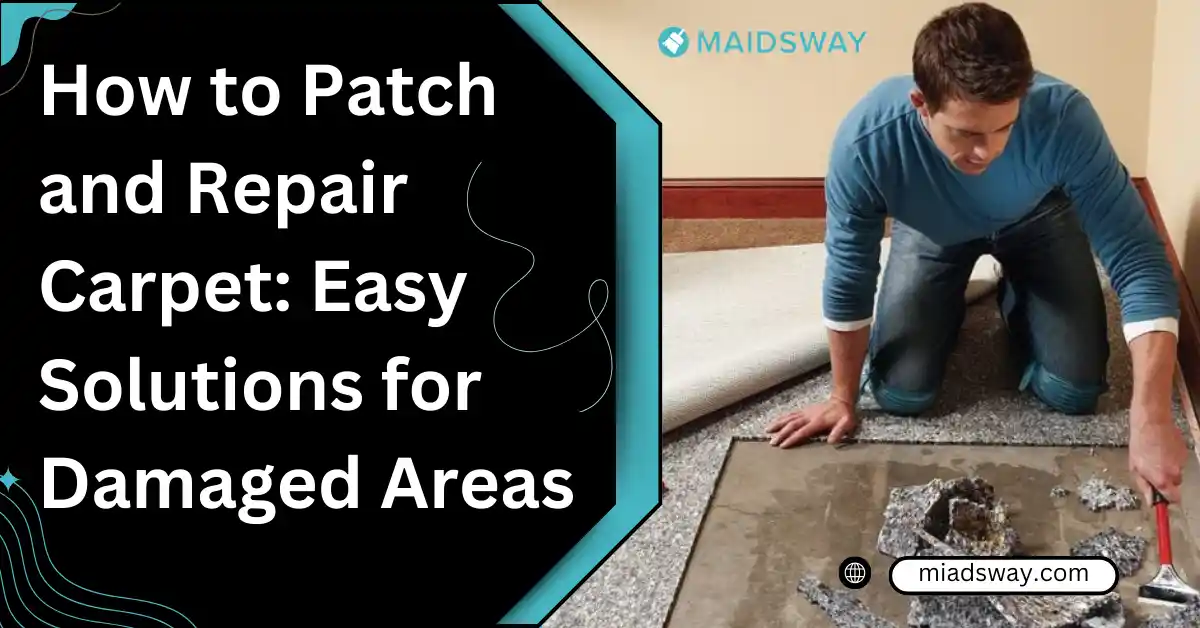How to Patch and Repair Carpet
Carpet Repair Average Costs. Carpet repairs cost between $100 and $400, with an average price of around $200 to $300. Carpet re-stretching costs $100 to $250 per room depending on the size of the room. Repairing damaged carpet might cost $100 to $250 per area. Or you can learn how to patch a damaged carpet from reading this article.
What You’ll Need
Before you begin, gather the following tools and materials:
- Carpet remnants or a piece from an inconspicuous area
- Carpet adhesive or double-sided carpet tape
- Utility knife or carpet cutter
- Measuring tape
- Seam roller
- Scissors
- Carpet tacks (optional)
- Carpet glue (for repairs)
How to Patch Carpet?
- You will need a remnant of your carpet. Begin by cutting a neat square around the hole or worn spot in your carpet with a utility knife and a straightedge. Cut completely and evenly through the rug’s backing, lifting as you go, avoiding any padding as well as the floor surface below.
- Using the remnant, make a patch identical in shape, size, design, and pile direction to the carpet section you removed. Test to see that the patch fits properly, and trim to make any necessary adjustments.
- Apply carpet adhesive in a thin layer to the underside of the patch and along each edge and the surrounding carpet.
- Carefully set the patch into the hole, then gently brush the pile so that the repaired section blends in seamlessly. Allow several hours for the adhesive to set before vacuuming over the repaired area.

How to Repair Carpets?
When done correctly, this repair eradicates the damaged area with minimal or no evidence. Remnants from the installation of the carpet make the job a little easier. If no remnants can be found cut a small portion of carpet from the back of a closet or other out-of-the-way space to provide a repair piece.
Step 1
Position an empty can (or another container of comparable size) on the nap side of the repair piece and press down firmly, allowing the rim to make a clear impression. Then cut around the outline using a sharp utility knife.
Use tape marked with an arrow to indicate the direction of the carpet’s nap on the repair piece. Then use another length of marked tape to identify the direction of the nap near the damaged area of the carpet.
Using the same can or container, press it down firmly over the damage.
Carefully cut along the outline with a utility knife. The diameter of a standard can is a good guideline for the size of a replacement piece. The goal is to keep the cut-out area as small as possible but still allow carpet tape to be inserted into the space and laid flat beneath the carpet backing.
Step 2
To ensure the carpet tape doesn’t work its way back through the opening, cut a length 2 to 3 inches wider than the diameter of the cut-out area. Carpet tape is available in double-sided and single-sided versions; the single-sided type generally works best for this type of repair.
Peel the backing away from the adhesive side of the tape and carefully insert the piece into the cut-out area, smoothing it flat from below so that it sticks firmly to the carpet backing around the perimeter of the opening.
Be patient and work carefully: handling the stickiness of the tape can be a challenge. For a cut-out this size, it generally works best to cover about half the space with one piece of tape and you cover the other half with a second piece of tape.
Essential Carpet Maintenance Tips for Long-Lasting Carpets
Regular maintenance is key to keeping your carpets looking new and minimizing the need for repairs.
Vacuum Regularly
Frequent vacuuming prevents dirt and debris from embedding in the carpet fibers, which can cause wear over time. Aim to vacuum high-traffic areas several times a week.Spot Clean Spills Immediately
Address spills as soon as they happen to prevent stains from setting. Blot (don’t rub) the spill with a clean cloth and use a carpet cleaner suitable for your carpet type.Rotate Furniture
To avoid permanent indentations, rotate your furniture periodically. This also ensures even wear across the carpet.Use Area Rugs and Mats
Protect high-traffic areas with area rugs or mats. This can help reduce wear and tear on your carpet, especially in entryways or hallways.Professional Cleaning
Have your carpets professionally cleaned at least once a year. Deep cleaning removes embedded dirt and allergens, extending the life of your carpet.
Conclusion
With the right tools and a little know-how patching a damaged carpet and how to repair carpet can be a simple and effective way to keep your floors looking great. By following these steps and maintaining your carpet regularly, you can enjoy a clean and comfortable home for years to come.

FAQs
How much does carpet repair cost?
The cost of carpet repair varies depending on the extent of the damage and whether you hire a professional or do it yourself. On average, professional carpet repair can range from $100 to $300 for minor repairs, while more extensive damage might cost upwards of $500.
How to repair a hole in your carpet?
To repair a hole in your carpet, start by cutting out the damaged area, ensuring that the cut is a clean, square, or rectangular shape. Then, cut a patch from a carpet remnant or an inconspicuous area that matches the hole’s size. Apply carpet adhesive or double-sided tape around the edges of the hole and carefully place the patch into the cutout, making sure the fibers align.
How to fix a patch in carpet?
If a patch in your carpet is not blending well or has come loose, you can fix it by lifting the patch and applying more carpet adhesive or tape underneath. Reposition the patch carefully, aligning the fibers with the existing carpet. Use a seam roller to press down and blend the edges.
What should I do if my carpet is wrinkling or buckling?
Wrinkling or buckling usually indicates that the carpet needs to be restretched. You can use a carpet stretcher to pull the carpet tight and re-tack it into place. For large areas, it may be best to hire a professional to ensure the job is done correctly.
How long does it take to repair a carpet?
The time it takes to repair a carpet depends on the extent of the damage. Small patches or seam repairs can typically be done in under an hour, while more extensive repairs, such as restretching, may take several hours or require multiple sessions.



